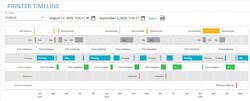Additive Manufacturing and the Connected Plant
COVID-19 has caused many manufacturing facilities to go online quicker than anticipated. That means the market for software that allows for remote monitoring and troubleshooting has exploded, especially for specialty equipment like 3D printers. Machine Design spoke with Mark Hessinger, vice president, Global Customer Services at 3D Systems, to get his thoughts on what sort of software additive manufacturing can provide for a better end-user experience.
Machine Design: What sort of software is out there that can help connect systems to the personnel using the system?
Mark Hessinger: What factories want to understand is what’s going on in the entire fleet they have. More and more systems are supporting things like Industry 4.0 and NT connect-type protocols so that the product—regardless of who it comes from—gives protocols out in an assisted format, and the users of the products usually use some type of software to combine that information.
We have a product called 3D Connect that we use for two purposes. One is to connect the information from the printers to the service organization so we can better support the customer. The same technology can be used by the customer to understand which machines are running, which ones are idle and which ones may have an error so they can see the full productivity of their fleet.
MD: When it comes to choosing software like 3D Connect, is there anything in particular that facilities should consider before they get it?
MH: From a facility perspective, when they’re buying any asset, it needs to support the protocol so they can get the information they want. Everything we currently produce, and all our future products, support that protocol. You can just take one of our printers and drop it into the network that the customer has, and it’ll give them the information they need.
MD: You mentioned that support of Industry 4.0 is important. How do you think that IoT implementation will change over the next few years?
MH: There’s the IoT for the customer and for us, the supplier of the equipment. I think it’s going to become more and more standard that you need to support that type of protocol because it’s becoming more and more of an expectation. To bring the information from the customer to us, we use Amazon Web Services. That enables us to understand what is going on for the customer and help manage uptime.
As far as other technologies, we’re using an AI tool—Aquant.io—mainly in our tech support area, but we have a proof-of-concept with them connecting AI on top of the IoT information to really refine it. The IoT information sends what’s happening, and you can use those statuses; like, if it goes over a threshold, it may be an issue and it may not be an issue. By applying something like AI, you could get more knowledge out of it.
We are exploring some things, for example, with AR. The first level is to help our own technicians when on-site, but also exploring how we can help customers remotely. We’ve started a little more energy on that with the COVID situation because it’s tougher to get to sites in certain cases. You’ve really got to take it a step forward so you can guide someone through AR. You can get better coverage from your field and you can also leverage some of the skills of the customer.
VR is a bit more expensive because of the amount needed to invest in software and tools to develop it. We’re also looking at VR for training purposes. Our healthcare business uses VR technology. It is very helpful to get doctors up-to-speed on how to do different operations, so it has proven itself, and we will continue to look at how we can leverage those technologies.
MD: How can smart factories take advantage of services like 3D Connect?
MH: Let’s go back to the support side. Traditionally, if a customer is running a piece of equipment and there is a problem, the operator notices and they call or email to start a support ticket, and we’d work with them and try to understand what the issue is. By using 3D Connect, we’re already getting the heartbeat of the system. We know what’s going on and we may actually see something that’s going slightly out-of-bounds before the customer even notices. That’s part of the goal: to use the technology to be proactive and see things before they happen.
About the Author

Marie Darty
Group Multimedia Director, Engineering & Manufacturing
Marie Darty is a digital media professional currently serving as the group multimedia director for the Manufacturing & Engineering Group at Endeavor Business Media. A graduate of Jacksonville State University, she earned her Bachelor of Arts in digital communication with a concentration in digital journalism in December 2016. In her current role, she leads the strategy and production of multimedia content, overseeing video series planning and editing. Additionally, she oversees podcast production and marketing of multimedia content.


